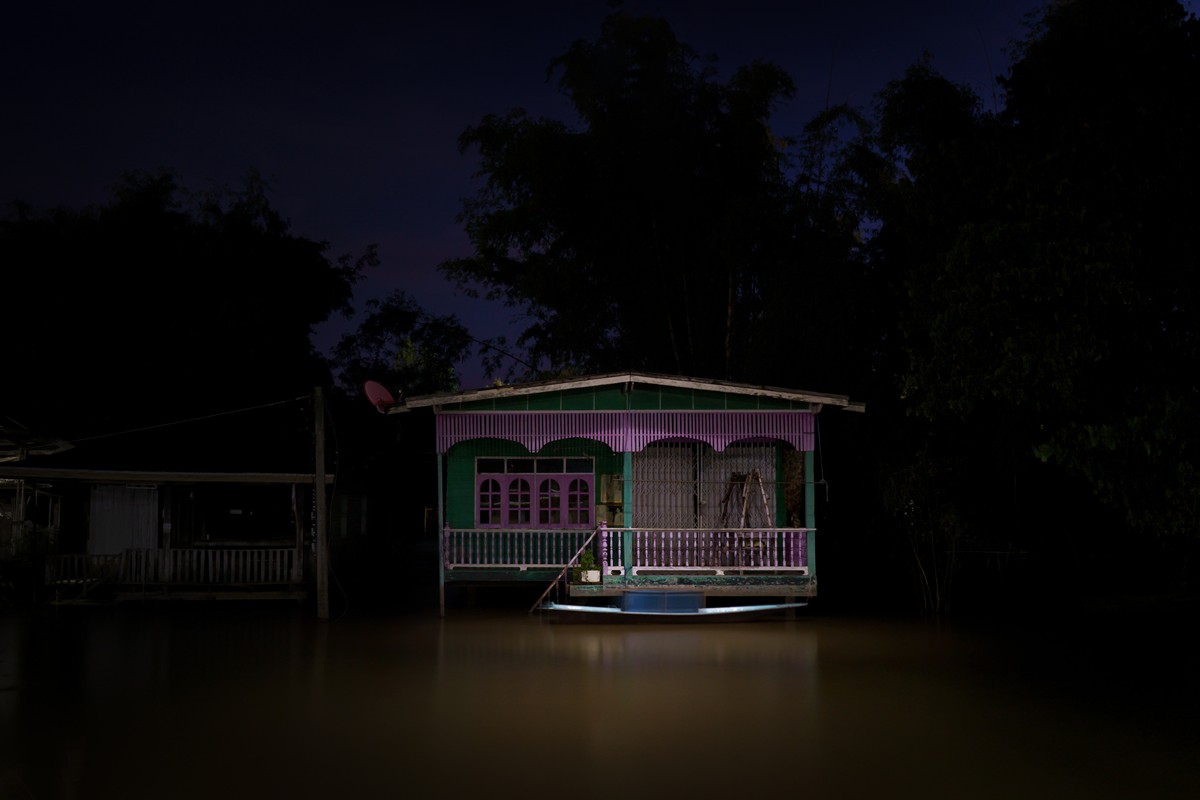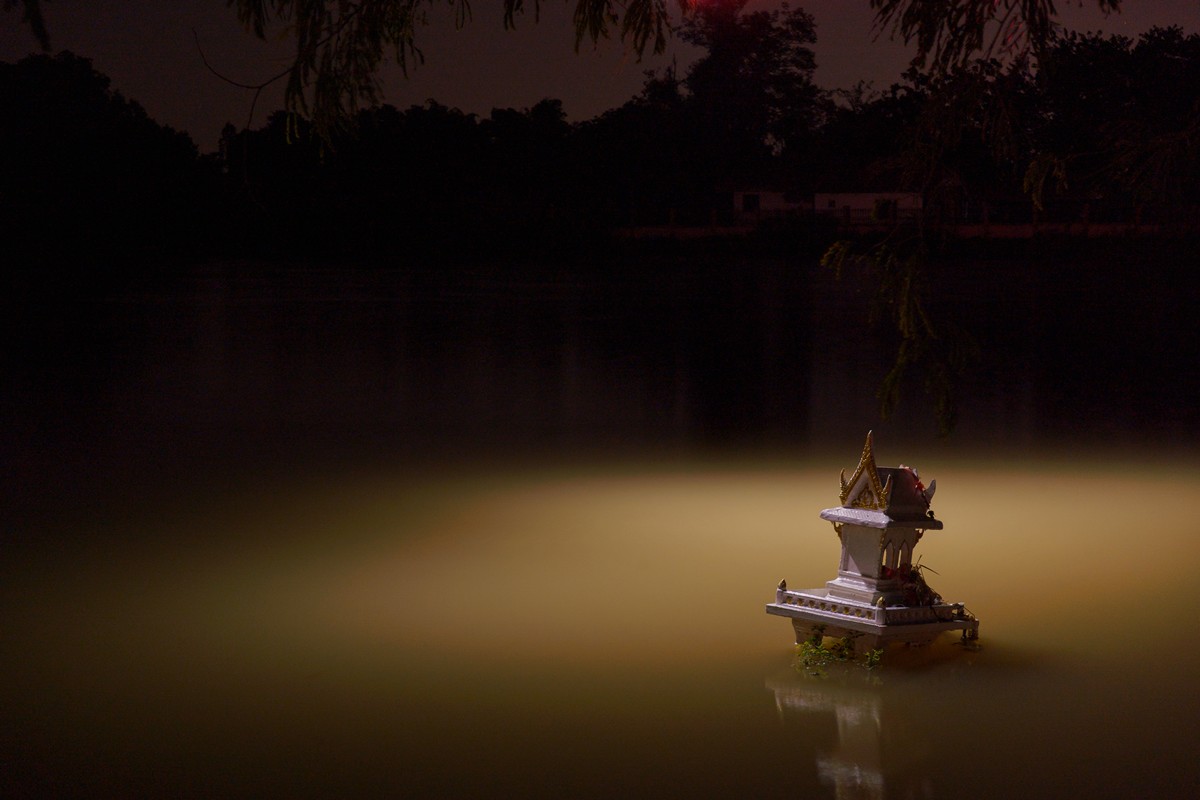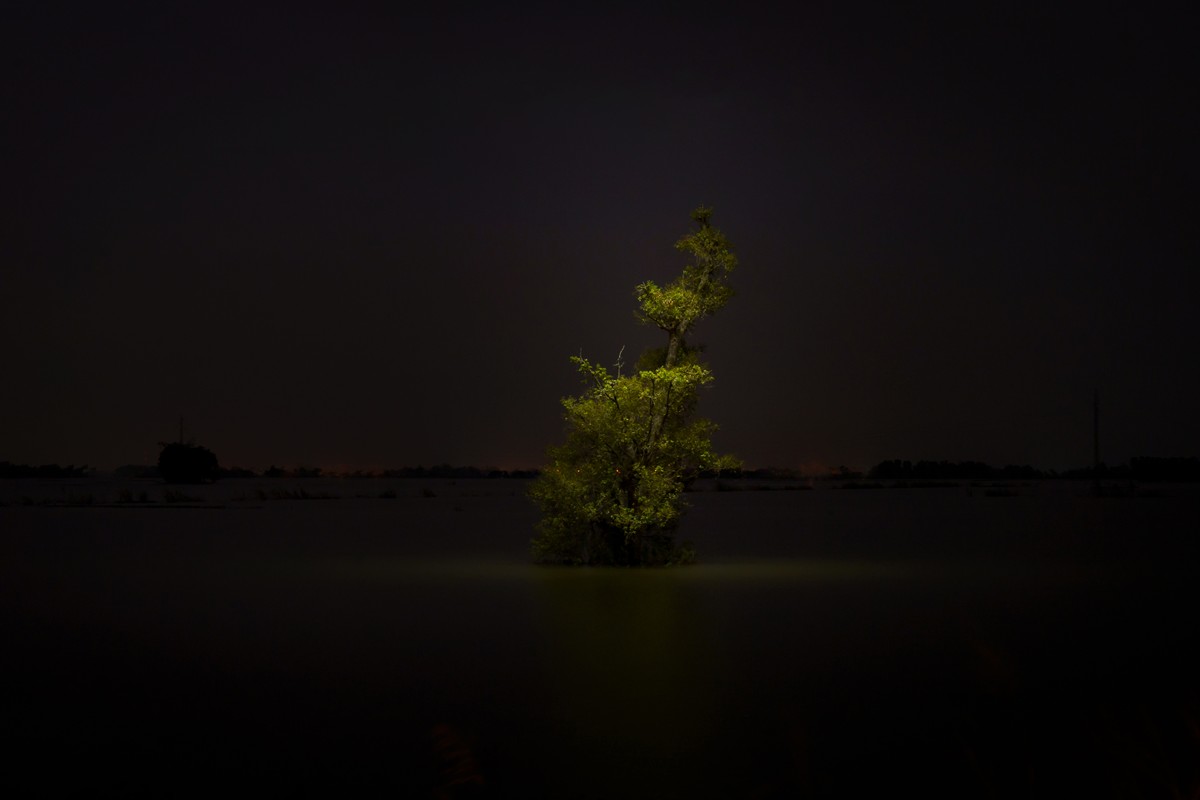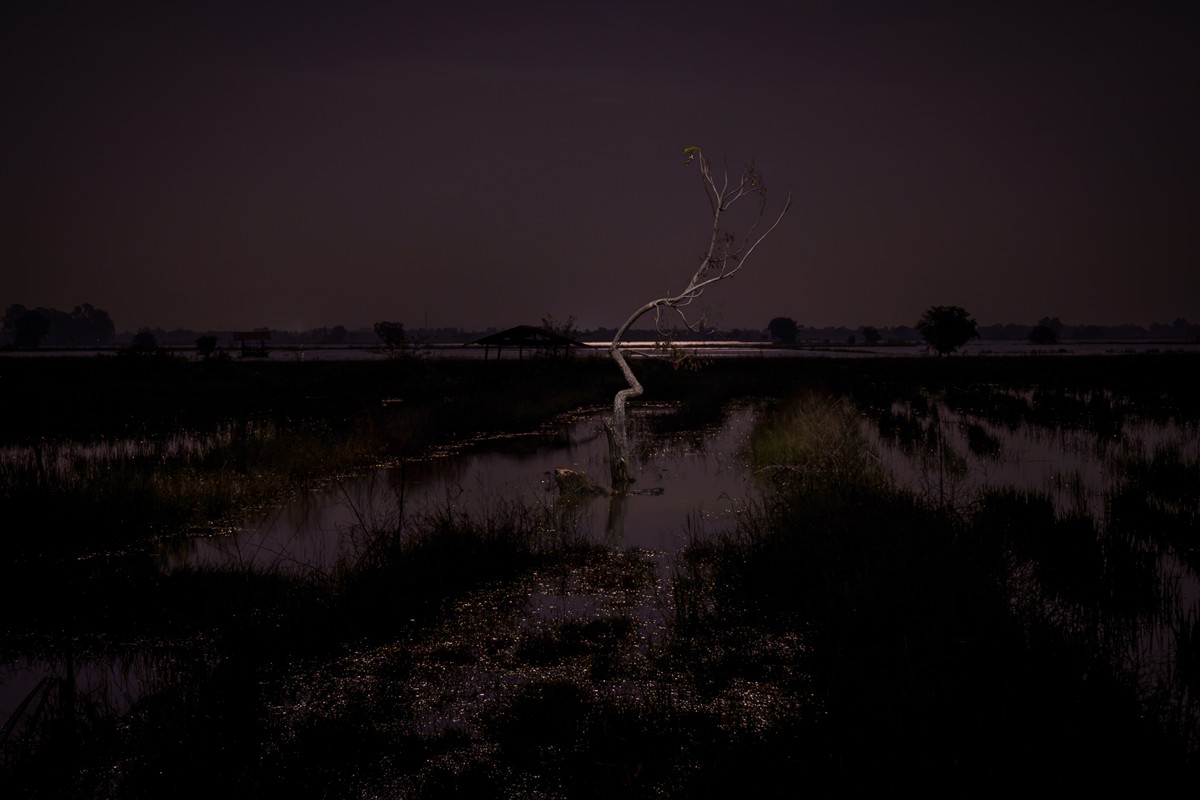Bang Rakam Model
October 30, 2025

ลักษณะเด่นอย่างหนึ่งของภาพถ่ายข่าว (Photojournalism) หรือสารคดี (Documentary Photography) คือการที่แสดงออกถึงเหตุการณ์ที่กำลังเกิดขึ้นในช่วงเวลาเหล่านั้น และมันได้คายผลลัพธ์ออกมาในเวลาเดียวกัน ยกตัวอย่างเช่น สถานการณ์ความรุนแรงทางการเมือง ภาพจะแสดงถึงสถานการณ์ที่เกิดขึ้น และผลลัพธ์กับสิ่งที่หลงเหลือจากเหตุการณ์นั้น ไม่ว่าจะเป็นความเสียหายของสถานที่ คนบาดเจ็บล้มตาย
ลักษณะเช่นนี้ศิลปะการถ่ายภาพที่ใช้ภาพแทน (Representation) หรือการยกเรื่องมาเปรียบเทียบ (Metaphor) ที่ส่วนมากจะสร้างขึ้นมาไล่หลังมาจึงไม่อาจครอบคลุมและทดแทนได้ทั้งหมด นำมาถึงข้อสังเกตที่ว่า ศิลปะภาพถ่ายต้องถูกขีดเส้นแบ่งระหว่างศิลปะภาพถ่ายที่มาจากสถานการณ์จริง และที่มาจากภาพถ่ายที่ถูกดัดแปลงด้วยกระบวนการต่าง ๆ หลังจากนั้น อย่างไรก็ดีทั้งสองวิธีสามารถนำไปสู่การแก้ปัญหาเดียวกันได้ในที่สุด ซึ่งในปัจจุบันดูจะแบ่งแยกกันยากขึ้นอย่างมีนัยยะสำคัญ จากความก้าวหน้าด้านเทคโนโลยีที่ความจริงแท้ทางภาพถ่ายไม่อาจพิสูจน์ได้ง่ายนักในทางปฏิบัติ

ตัวอย่างหนึ่งที่น่าสนใจคือ การเกิดเหตุการณ์หลุมยุบเมื่อวันที่ 24 กันยายน 2025 หน้าวชิรพยาบาล และสถานีตำรวจสามเสน ซึ่งเป็นหลุมยุบขนาดใหญ่ครั้งแรกเท่าที่เคยมีมาในกรุงเทพฯ มีภาพข่าวทางสังคมออนไลน์ในช่วงเช้าตรู่ ตอนนั้นหลายคนไม่เชื่อว่าเป็นภาพถ่ายจริง และคิดว่าเป็นภาพที่สร้างจากปัญญาประดิษฐ์ (AI-generated Image) เนื่องจากไม่เคยเห็นเรื่องพวกนี้เกิดขึ้นมาก่อน และภาพก็ค่อนข้างจะเหนือจริงไปสักหน่อย
หลังจากนั้นเมื่อเหตุการณ์ผ่านไป ภาพหลุมยุบถูกนำมาดัดแปลงด้วย AI ให้มีสิ่งต่าง ๆ โผล่ออกมาจากหลุมนั้นกันอย่างสนุกสนาน การใช้ความจริงและไม่จริงปะปนกัน รวมทั้งกระบวนการหลากหลายมาสะท้อนถึงต้นตอปัญหา ที่เป็นลักษณะเดียวกันกับวิธีของศิลปะภาพถ่ายร่วมสมัย อย่างกรณีภาพน้ำท่วมหลังฝนตกในกรุงเทพฯ สมัยที่ยังไม่มี AI เหล่าชาวสังคมออนไลน์ก็ใช้ Photoshop ตัดต่อเอาสัตว์ประหลาด หรือนักการเมืองที่ต้องรับผิดชอบโผล่ขึ้นมาเช่นกัน
ปรากฏการณ์นี้อาจสามารถมองเลยไปถึงเรื่องการเพิกเฉยต่อปัญหาใด ๆ ที่เกิดขึ้นได้ เพราะการที่มีภาพถ่ายจำลองเข้ามาเป็นตัวแปรหนึ่งในการตอบสนองต่อการตัดสินใจ มันอาจทำให้เกิดปัญหาถึงชีวิตได้ถ้าคิดในกรณีที่แย่ที่สุดอย่างเช่นกรณีก่อนหน้านี้ ถ้าเราคิดว่าหลุมยุบเป็นภาพปลอมแล้วนั่งหัวร่ออยู่เฉย ๆ เราก็อาจจะตกลงไปในหลุมนั้นได้ถ้าไม่รีบหนีซะก่อน หรือฉากทัศน์ที่ดูเหนือจริงแบบอื่น ๆ กระทั่งปัญหาทางสังคมที่ต้องการให้เกิดการตระหนักรู้ และมาตราการแก้ไขก็อาจถูกเพิกเฉยด้วย วันนี้อาจยังไม่เห็นชัดเจนนักแต่ในอนาคต (ที่คาดว่าน่าจะใกล้แล้ว) พวกเราจะได้เห็นเรื่องเหล่านี้มากขึ้น

งานภาพถ่ายผลลัพธ์ของเหตุการณ์ที่เด่นชัดและอาจยกมาเป็นตัวอย่าง เช่น ภาพของขวดที่หลอมละลายจากระเบิดปรมาณูที่เมืองนางาซากิ [Bottle Melted and Deformed by Atomic Bomb Heat, Radiation and Fire, Nagasaki”, 1961] และสภาพผิวหนังของผู้ที่รอดชีวิตจากระเบิดในครั้งนั้น โดยช่างภาพชาวญี่ปุ่น โชเม โตมัตสึ (Shomei Tomatsu) หรืองานที่ชื่อ Aftermath - World Trade Center โดยช่างภาพ โจเอล เมเยอโรวิตซ์ (Joel Meyerowitz) ที่เข้าไปเก็บภาพบริเวณที่เรียกว่า Ground Zero หลังจากการเหตุการณ์ 9/11 งานชุดนี้มีทั้งสภาพความเสียหายหลักเกิดเหตุ การเก็บกู้ซากอาคาร และภาพบุคคลของเจ้าหน้าที่ที่ทำงานอย่างหนักในเวลานั้น
มหาอุทกภัยของไทยที่เกิดขึ้นเมื่อปี 2011 เหตุการณ์นี้กินระยะเวลากว่า 6 เดือน ศิลปินชาวไทยอย่างมิติ เรืองกฤตยา (Miti Ruangkritya) และ เล็ก เกียรติกิติขจร (Lek Kiatsirikajorn) ถ่ายทอดความวิบัติในครั้งนั้นในรูปแบบที่ใกล้เคียงกัน—Imagining Flood (2011) ของมิตินำเสนอภาพน้ำท่วมในยามค่ำคืนราวกับเมืองร้าง มีเพียงแสงไฟนีออนฉายจับไปยังสิ่งต่าง ๆ อย่างเย็นชืดและวังเวง ส่วน Flowing Through The Wreckage of Despair ของเล็กถ่ายทอดทิวทัศน์กรุงเทพฯ ที่เต็มไปด้วยน้ำท่วมในฉากกลางวัน มีหลายภาพแสดงถึงผู้คนยืนพ้นน้ำขึ้นมาครึ่งตัว มองทอดสายตาไปยังสภาพเมือง และอาจรวมไปถึงอนาคตที่คาดเดาอะไรไม่ได้ขณะนั้น มันเป็นผลลัพธ์ของอะไรบางอย่างที่ประชาชนตัวเล็ก ๆ ไม่สามารถควบคุมได้ และยากที่จะหลีกเลี่ยง

โครงการภาพถ่ายที่กำลังนำเสนอชุดนี้มีชื่อว่า บางระกำโมเดล (Bang Rakam Model) โดยช่างภาพ จิรวัฒน์ ตันประเสริฐ (Jirawat Tunprasert) เป็นภาพชุดตอนกลางคืนที่เก็บภาพผลลัพธ์ที่หลงเหลือจากโครงการบริหารจัดการน้ำในพื้นที่ลุ่มต่ำของลุ่มน้ำยม ‘บางระกำโมเดล’ ที่เปลี่ยนพื้นที่บริเวณทุ่งบางระกำ จังหวัดพิษณุโลกและสุโขทัย อันเป็นพื้นที่น้ำท่วมซ้ำซาก ให้เป็น “ทุ่งหน่วงน้ำ” (Water Retention Area) หรือ “แก้มลิง” โดยให้ชุมชนมีส่วนร่วมในการบริหารจัดการน้ำ เช่น การเลื่อนทำนาให้เร็วขึ้น หารายได้เสริมจากการทำประมงในพื้นที่น้ำท่วม หากผลกระทบเชิงลบก็มีเช่นกัน อาทิ การแบกรับภาระสาธารณะในการเสียสละพื้นที่เพื่อประโยชน์ส่วนรวมทำให้การดำเนินชีวิตไม่สะดวก ต้องใช้เรือในการสัญจร และบางส่วนต้องย้ายไปอาศัยในที่พักชั่วคราว, บ้านเรือนและโครงสร้างพื้นฐานเสียหายจากน้ำที่ท่วมเป็นเวลานาน, การชดเชยที่ไม่เป็นธรรม เป็นต้น
แต่ละภาพของโครงการภาพถ่ายของจิรวัฒน์ แสดงถึงสิ่งที่ยืนโดดเดี่ยวท่ามกลางน้ำท่วม มีแสงไฟฉายตกลงมากระทบจากด้านบน (ใช้โดรนส่องแสงลงมา) ดูแล้วไม่ต่างกับนักแสดงที่กำลังร่ายรำบนเวที งานชิ้นนี้ทำให้นึกถึงงาน Seascape (2015) ของไอเฟิล ชอง (Eiffel Chong) ที่พูดถึงสิ่งก่อสร้างของมนุษย์และธรรมชาติที่อยู่ร่วมกันอย่างสงบสุข หรือย้อนกลับไปถึงงานของมิติชุด Imagining Flood ที่กล่าวถึงก่อนหน้านี้ เราเห็นภาพถ่ายที่ลึกลับสวยงามของถนน บ้านเรือน เสาไฟฟ้า ศาลพระภูมิ ถูกน้ำเข้ามาแทนที่ งานด้านภาพฉุดให้ผู้ชมหลงใหลไปกับความงามของแสงและวัตถุที่เปิดบทสนทนากัน แต่หากมองทะลุผ่านความงามที่เคลือบไว้นั้นไปถึงแนวคิดและความเป็นจริง มันคือความกระอักกระอ่วนที่ย้อนทางกลับขึ้นมาแทน
‘บางระกำโมเดล’ แสดงให้เห็นอย่างชัดแจ้งถึงปรากฏการณ์ที่กำลังดำเนินไป และผลลัพธ์บางอย่างที่ถูกคายทิ้งไว้พร้อม ๆ กัน เหตุการณ์กำลังเกิดขึ้นซ้ำแล้วซ้ำเล่า และเลวลงทุกปีจากความผันผวนของสภาวะสิ่งแวดล้อมระดับโลกอันยากที่จะจัดการด้วยระยะเวลาอันสั้น ทางออกที่เคยได้ผลในอดีตยังจะทำงานอย่างมีประสิทธิภาพหรือไม่นั้นเป็นเรื่องที่ต้องขบคิด
ภาพผลลัพธ์จากเรื่องจริงทำงานในรูปแบบที่เกี่ยวข้องกับเวลาที่เดินไปอย่างไม่หยุดยั้ง ส่งผลต่อความเป็นไปรอบ ๆ พื้นที่ที่ผลลัพธ์นั้นอาศัยอยู่ เกี่ยวพันกับความเป็นความตายในเชิงชีวภาพทั้งเรื่องส่วนรวมและปัจเจก เหล่านี้คือความสำคัญยิ่งใหญ่ของภาพถ่ายที่สร้างขึ้นมาจากเรื่องจริง-สถานการณ์จริง อันยากที่ใครจะปฏิเสธพลังอำนาจของภาพถ่ายแขนงนี้ได้
เกี่ยวกับศิลปิน
จิรวัฒน์ ตันประเสริฐ ช่างภาพอิสระ เคยเป็นอาจารย์พิเศษสอนถ่ายภาพที่มหาวิทยาลัยเชียงใหม่ระยะเวลาหนึ่ง งานภาพถ่ายของเขาเคยได้รับรางวัลและจัดแสดงทั้งในประเทศไทยและต่างประเทศ จิรวัฒน์ได้รับแรงบันดาลใจมาจากเรื่องราวต่าง ๆ ในชีวิตและสิ่งที่เขาสนใจ อาทิ ธรรมชาติ ศิลปะ ดนตรี และผู้คน
https://jirawattun.myportfolio.com

One of the defining characteristics of photojournalism or documentary photography is its ability to depict events as they unfold in real time, while simultaneously revealing their outcomes. For instance, in situations of political violence, photographs present both the unfolding of the event and its aftermath, showing traces such as damaged locations, injured people, and deaths.
This quality distinguishes such photography from artistic practices based on representation or metaphor, which are usually created retrospectively and therefore cannot fully encompass or substitute for the immediacy of real events. This leads to an observation that photographic art must be understood through a distinction between works derived from actual situations and those created through post-production or other manipulative processes. Nevertheless, both approaches can ultimately lead to the same conceptual outcome. However, the distinction between them has become increasingly blurred due to technological advancements that make it difficult to verify photographic truth in practice.

An interesting example is the sinkhole incident on September 24, 2025, in front of Vajira Hospital and the Samsen Police Station, which was the first major sinkhole ever recorded in Bangkok. Early that morning, images of the event circulated widely on social media. Many people did not believe they were real photographs, assuming instead that they were AI-generated images, since such phenomena had never been witnessed before and the photographs appeared rather surreal.
Later, after the event unfolded, the sinkhole images were further manipulated using AI, creating humorous variations in which different objects or figures were emerging from the hole. The blending of the real and the unreal, together with various creative processes, reflects the root causes of problems, a method characteristic of contemporary photographic art. A similar tendency could be observed before the advent of AI-generated imagery, when social media users in Bangkok edited photographs of post-rain flooding with Photoshop, inserting monsters or politicians held responsible for the situation.
This phenomenon may also point to a growing indifference to real issues, since the presence of simulated images can affect how people respond to situations and make decisions. In the worst-case scenario, as in the sinkhole incident, disbelief in a photograph’s authenticity could lead to real harm. If one assumed the image was fake and simply laughed it off, one might have fallen into the hole by failing to act in time. Other surreal scenarios, or even social problems that require awareness and collective action, could similarly be ignored. While this may not yet be entirely evident today, such situations are likely to become more visible in the near future.

A clear example of photographic work that captures the aftermath of major events is Bottle Melted and Deformed by Atomic Bomb Heat, Radiation and Fire, Nagasaki (1961) by Japanese photographer Shomei Tomatsu, which shows a glass bottle deformed by the atomic explosion, along with portraits of bomb survivors. Another is Aftermath – World Trade Center by Joel Meyerowitz, who documented the area known as Ground Zero after the 9/11 attacks. His series includes images of the devastated site, the recovery of debris, and portraits of the workers who labored tirelessly there.
Thailand’s 2011 Great Flood, which lasted for more than six months, also inspired several photographic projects. Thai photographers Miti Ruangkritya and Lek Kiatsirikajorn documented the disaster in different yet related ways. Miti’s Imagining Flood (2011) presents nighttime flood scenes that resemble an abandoned city, illuminated only by cold neon lights that evoke stillness and melancholy. In contrast, Lek’s Flowing Through the Wreckage of Despair portrays Bangkok’s flooded landscapes in daylight, with figures standing half-submerged and gazing toward the uncertain horizon. Both bodies of work capture a sense of helplessness among ordinary citizens, reflecting outcomes that could neither be controlled nor easily avoided.

The photographic project Bang Rakam Model by photographer Jirawat Tunprasert, continues this exploration. Shot at night, the series documents the remaining traces of the Bang Rakam Model water management project in the floodplains of the Yom River Basin, located in Phitsanulok and Sukhothai provinces. This project sought to transform the flood-prone Bang Rakam area into a “water retention area” or “monkey cheek”, with local communities participating in water management through practices such as advancing rice cultivation and earning supplementary income from fishing. However, there were also negative impacts: residents had to bear the public burden of sacrificing their land for the common good, leading to disruptions in daily life, dependence on boats for transportation, temporary relocation, and damage to houses and infrastructure from prolonged flooding, as well as issues of unfair compensation.
Each photograph in Jirawat’s series captures a lone object amid the floodwaters, bathed in drone light, like an actor under a spotlight. This work recalls Eiffel Chong’s Seascape (2015), which reflects on the peaceful coexistence of human-made structures and nature, and also echoes Miti Ruangkritya’s Imagining Flood mentioned earlier. The photographs of streets, houses, electricity poles, and spirit houses submerged in water are visually captivating, drawing viewers in with their mysterious beauty and delicate play of light. Yet beyond this surface beauty lies an underlying unease that resurfaces upon reflection.

Photographs born from real circumstances operate within the continuous passage of time, shaping the environments in which their outcomes persist. They touch upon the conditions of life and death, both collective and individual, at a biological level. This is the enduring significance of photographs born from real situations: a power that no one can truly deny.
About the Artist
Jirawat Tunprasert is a freelance photographer and a former guest photography lecturer at Chiang Mai University. His photographic works have received awards and been exhibited both in Thailand and abroad. Jirawat draws inspiration from various aspects of life and the things that interest him, such as nature, art, music, and people.
https://jirawattun.myportfolio.com
This quality distinguishes such photography from artistic practices based on representation or metaphor, which are usually created retrospectively and therefore cannot fully encompass or substitute for the immediacy of real events. This leads to an observation that photographic art must be understood through a distinction between works derived from actual situations and those created through post-production or other manipulative processes. Nevertheless, both approaches can ultimately lead to the same conceptual outcome. However, the distinction between them has become increasingly blurred due to technological advancements that make it difficult to verify photographic truth in practice.

An interesting example is the sinkhole incident on September 24, 2025, in front of Vajira Hospital and the Samsen Police Station, which was the first major sinkhole ever recorded in Bangkok. Early that morning, images of the event circulated widely on social media. Many people did not believe they were real photographs, assuming instead that they were AI-generated images, since such phenomena had never been witnessed before and the photographs appeared rather surreal.
Later, after the event unfolded, the sinkhole images were further manipulated using AI, creating humorous variations in which different objects or figures were emerging from the hole. The blending of the real and the unreal, together with various creative processes, reflects the root causes of problems, a method characteristic of contemporary photographic art. A similar tendency could be observed before the advent of AI-generated imagery, when social media users in Bangkok edited photographs of post-rain flooding with Photoshop, inserting monsters or politicians held responsible for the situation.
This phenomenon may also point to a growing indifference to real issues, since the presence of simulated images can affect how people respond to situations and make decisions. In the worst-case scenario, as in the sinkhole incident, disbelief in a photograph’s authenticity could lead to real harm. If one assumed the image was fake and simply laughed it off, one might have fallen into the hole by failing to act in time. Other surreal scenarios, or even social problems that require awareness and collective action, could similarly be ignored. While this may not yet be entirely evident today, such situations are likely to become more visible in the near future.

A clear example of photographic work that captures the aftermath of major events is Bottle Melted and Deformed by Atomic Bomb Heat, Radiation and Fire, Nagasaki (1961) by Japanese photographer Shomei Tomatsu, which shows a glass bottle deformed by the atomic explosion, along with portraits of bomb survivors. Another is Aftermath – World Trade Center by Joel Meyerowitz, who documented the area known as Ground Zero after the 9/11 attacks. His series includes images of the devastated site, the recovery of debris, and portraits of the workers who labored tirelessly there.
Thailand’s 2011 Great Flood, which lasted for more than six months, also inspired several photographic projects. Thai photographers Miti Ruangkritya and Lek Kiatsirikajorn documented the disaster in different yet related ways. Miti’s Imagining Flood (2011) presents nighttime flood scenes that resemble an abandoned city, illuminated only by cold neon lights that evoke stillness and melancholy. In contrast, Lek’s Flowing Through the Wreckage of Despair portrays Bangkok’s flooded landscapes in daylight, with figures standing half-submerged and gazing toward the uncertain horizon. Both bodies of work capture a sense of helplessness among ordinary citizens, reflecting outcomes that could neither be controlled nor easily avoided.

The photographic project Bang Rakam Model by photographer Jirawat Tunprasert, continues this exploration. Shot at night, the series documents the remaining traces of the Bang Rakam Model water management project in the floodplains of the Yom River Basin, located in Phitsanulok and Sukhothai provinces. This project sought to transform the flood-prone Bang Rakam area into a “water retention area” or “monkey cheek”, with local communities participating in water management through practices such as advancing rice cultivation and earning supplementary income from fishing. However, there were also negative impacts: residents had to bear the public burden of sacrificing their land for the common good, leading to disruptions in daily life, dependence on boats for transportation, temporary relocation, and damage to houses and infrastructure from prolonged flooding, as well as issues of unfair compensation.
Each photograph in Jirawat’s series captures a lone object amid the floodwaters, bathed in drone light, like an actor under a spotlight. This work recalls Eiffel Chong’s Seascape (2015), which reflects on the peaceful coexistence of human-made structures and nature, and also echoes Miti Ruangkritya’s Imagining Flood mentioned earlier. The photographs of streets, houses, electricity poles, and spirit houses submerged in water are visually captivating, drawing viewers in with their mysterious beauty and delicate play of light. Yet beyond this surface beauty lies an underlying unease that resurfaces upon reflection.

The Bang Rakam Model clearly reveals an ongoing phenomenon and the traces it continues to leave behind. The event recurs again and again, worsening each year amid global environmental fluctuations that cannot be addressed within a short span of time. Whether the solutions that once proved effective in the past can still function today remains an open question.
Photographs born from real circumstances operate within the continuous passage of time, shaping the environments in which their outcomes persist. They touch upon the conditions of life and death, both collective and individual, at a biological level. This is the enduring significance of photographs born from real situations: a power that no one can truly deny.
About the Artist
Jirawat Tunprasert is a freelance photographer and a former guest photography lecturer at Chiang Mai University. His photographic works have received awards and been exhibited both in Thailand and abroad. Jirawat draws inspiration from various aspects of life and the things that interest him, such as nature, art, music, and people.
https://jirawattun.myportfolio.com
